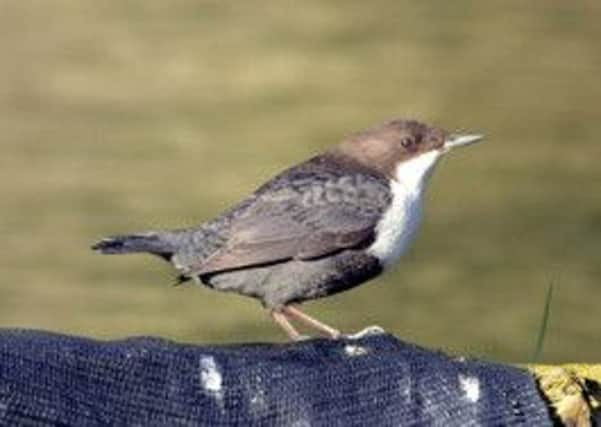Birdwatch: Dippers


After a couple of quiet months the males are singing again, a loud sweet wren-like song echoes from the banks and is so high pitched it can be heard above the background sound of moving water.
The male bobs up and down displaying his white breast and white eyelids while singing in further attempts to attract a female. They have reunited after holding rival territories next to each other for the winter which they will only leave if they are driven away by harsh weather.
Advertisement
Hide AdAdvertisement
Hide AdOnce paired up dippers build moss lined nests in crevices, often used by successive generations and often under man-made structures such as bridges. There have been more extreme examples such as a pair that nested on the wheel of an active water mill and another that nested inside the boot of a car dumped in a river in Northern Ireland.
Some pairs are on between three and six eggs by the end of this month. In good years some pairs can have second broods.
In recent times, dippers have expanded their range further downstream on Yorkshire rivers such as the Aire and Don which are now cleaner and can support invertebrates such as mayfly nymphs and caddisfly larvae that dippers feed on.
One of the best known places to look for them is on the River Wharfe at Bolton Abbey, upstream from the Cavendish Pavilion, and they are often seen on Scalby Beck, north of Scarborough.
Advertisement
Hide AdAdvertisement
Hide AdThere are several subspecies of dipper and the one seen here is gularis which has rusty brown underparts contrasting with the large white bib.
The nominate race, cinclus, breeds in the mountains of Norway - where it is the national bird - and Sweden, and has all-black underparts. These black-bellied dippers move south for the winter and can turn up in this country; one was seen this week near Harpham Moor, East Yorkshire.
One was reported on the Aire at Shipley in the winter of 2011/12 while many birders saw one at Watton, East Yorkshire in the winter of 2007/8.
A North American duck, a drake surf scoter, was first seen off Filey Brigg on Saturday and was still present this week in the same area as the drake seen in June and July 2013.
Advertisement
Hide AdAdvertisement
Hide AdA drake American wigeon was seen again on the main lake at Swillington Ings, Leeds on Sunday and the following day at Loscoe Lake, Normanton after leaving the Nosterfield reserves in North Yorkshire while a drake green-winged teal continued to be seen on the RSPB’s Saltholme reserve on Teesside.
Another great grey shrike has been seen in South Yorkshire, this time on a golf course at Bawtry. Anyone coming to see the bird must first report to the clubhouse for directions. Meanwhile, great grey shrikes are still being seen from the watchpoint at Midhope Moor and on Thorne Moors.
An adult Kumlien’s gull, up to three Iceland gulls and two glaucous gulls have been seen among up to 3,000 large gulls feeding in fields around the Rufforth airfield near York.